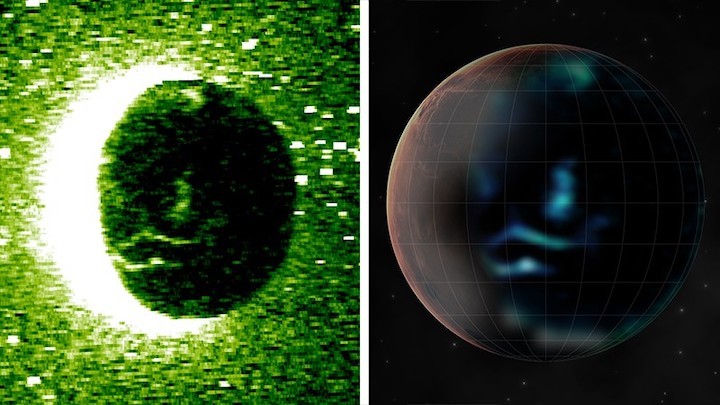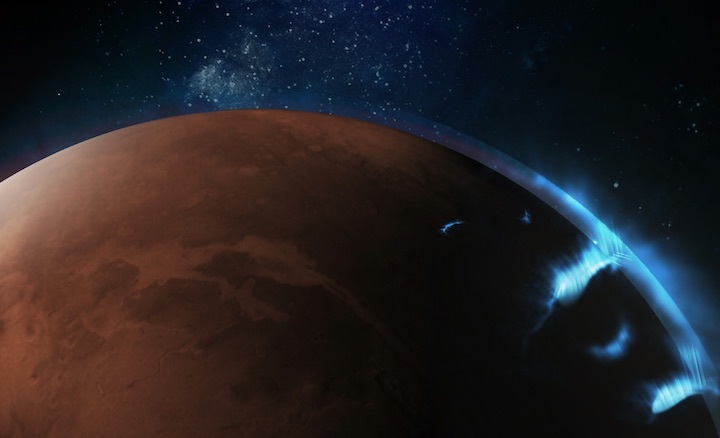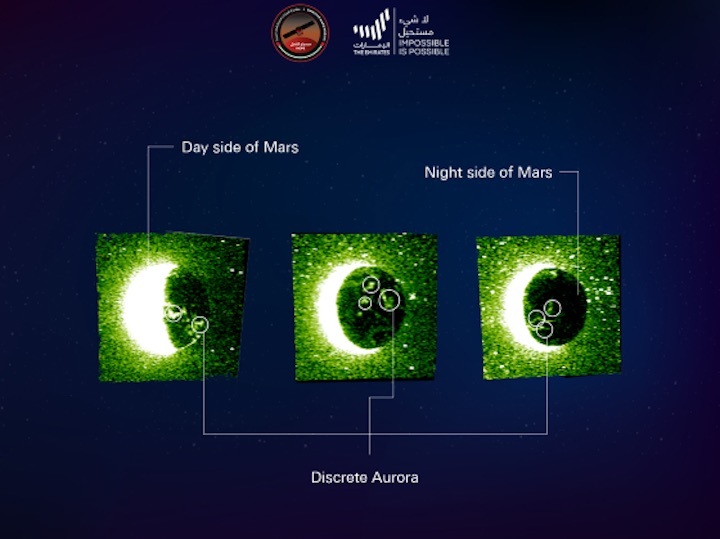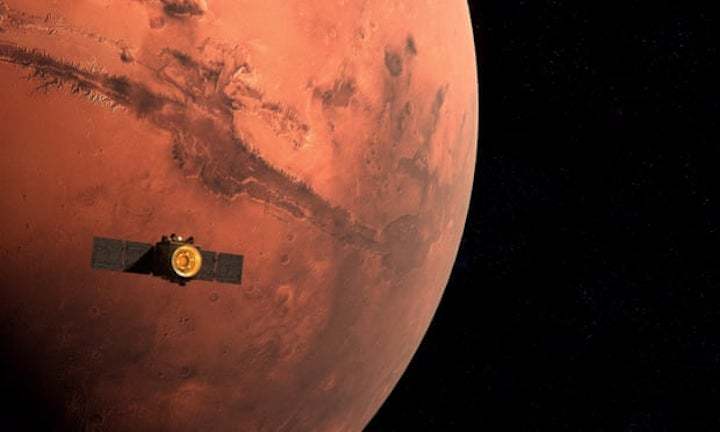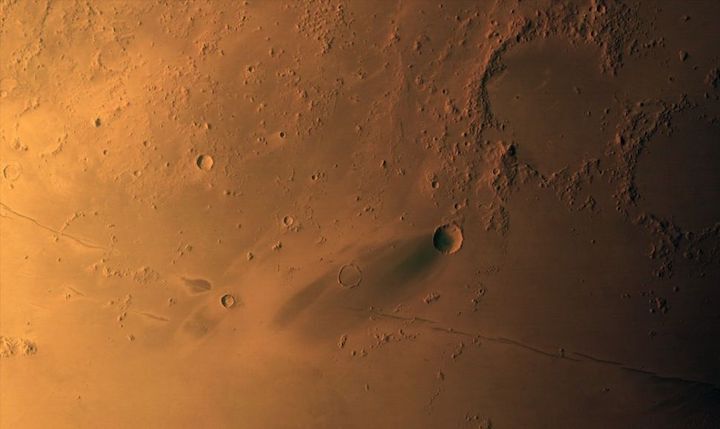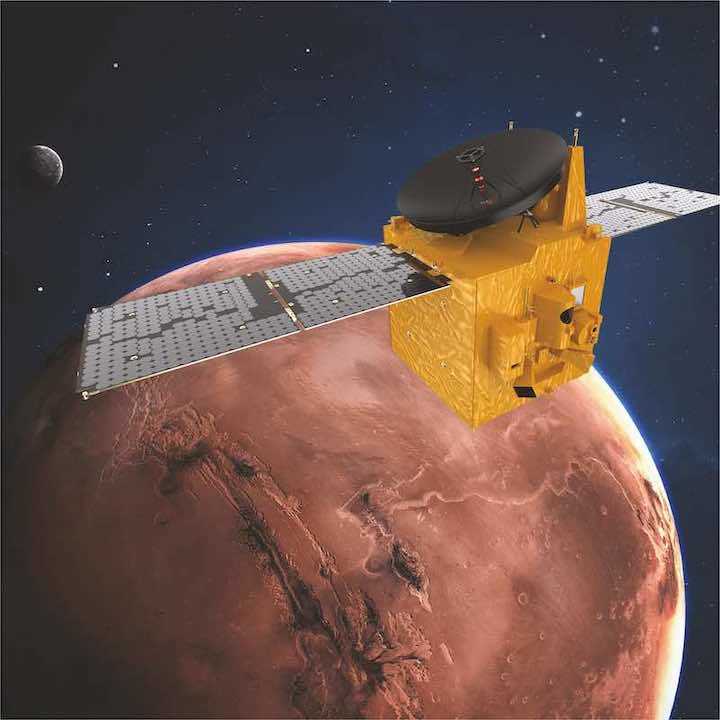
Key takeaways:
- March 9th marks one month since the Hope Probe successfully entered into orbit around Mars.
- The Emirates Ultraviolet Spectrometer (EMUS) took its first science images on February 20th, 2021, providing information on the composition of Mars’ upper atmosphere.
- The orbiter, named ‘Hope’ (Al Amal in Arabic), and two of the three science instruments on board, Emirates eXploration Imager (EXI) and Emirates Mars Ultraviolet Spectrometer (EMUS) were developed at LASP in partnership with MBRSC engineers.
- The mission, the first interplanetary exploration undertaken by an Arab nation, will spend one Martian Year (about two Earth years) orbiting around the red planet gathering crucial scientific data on its atmosphere.
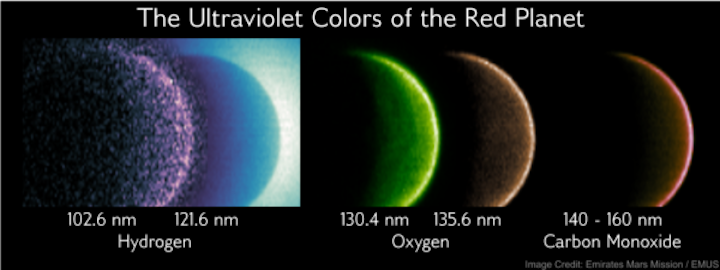
False-color images from the EMUS instrument. Violet (102.6 nm) and blue (121.6 nm) show the reflection of sunlight from the extended cloud of hydrogen atoms surrounding the planet. Green (130.4 nm) shows the reflection of sunlight from oxygen atoms in the upper atmosphere. Orange (135.6 nm) shows energetic electrons causing other oxygen atoms to glow, similar to a fluorescent lamp. Red (140-160 nm) shows a combination of emissions coming from carbon monoxide molecules. Credit: Emirates Mars Mission / EMUS
The Emirates Mars Mission (EMM), the first interplanetary exploration undertaken by an Arab nation, achieved another major milestone on February 20th, 2021 with the return of the first science images from the Emirates Ultraviolet Spectrometer (EMUS), one of three science instruments on board the Hope probe. The Mohammed bin Rashid Space Centre (MBRSC) released these images to mark one month since the Probe successfully entered into orbit around Mars on February 9, 2021.
“We are very excited indeed to be moving into our science orbit and starting the flow of planetary data we aim to gather over the coming Martian year,” said EMM Science Lead Hessa Al Matroushi.
EMUS collected its first series of images from an orbit altitude of 36,000 km. Each false-color image represents light collected at a different ultraviolet wavelength providing information on the composition of Mars’ upper atmosphere. EMUS is the first instrument to orbit Mars with the capability to measure the extreme ultraviolet wavelength region.
The EMUS spectrometer will measure global characteristics and variability of hydrogen and oxygen in the Mars upper atmosphere, right at the edge of space. The images show the measured signal from scattered sunlight off hydrogen and oxygen and emission from carbon monoxide in the Mars thermosphere, produced by the breakdown of water and carbon dioxide in the atmosphere.
“Moments like these, when the first science data comes back from an instrument you’ve been working on for years, are always special. With the EMUS instrument we’ll be able to see how the upper atmosphere of Mars behaves in new ways, and at new wavelengths,” noted Dr. Mike Chaffin, EMUS Instrument Scientist
“There is something unique and special about seeing the unseen universe with an ultraviolet instrument. Seen photons are sweet, but those unseen are sweeter,” said Dr. Justin Deighan, EMUS instrument scientist.
EMUS observations will improve our knowledge of how the upper and lower atmosphere of Mars are connected and how the atmosphere has been slowly lost to space over the history of the solar system.
“I was impressed by how similar these first images compared to our model simulations. But while we can predict many aspects of the Mars atmosphere, there are many unknowns that will be investigated throughout the mission, such as how the atmosphere has been lost to space over time,” said Dr. Greg Holsclaw, EMUS instrument scientist.
“We have already amassed some 60 gbits of data from Hope’s instruments in the mission so far,” said EMM Science Lead Hessa Al Matroushi. “Alongside early data streams from EMUS and its companion instrument EMIRS, we have also been able to take a range of highly detailed images of the planet using our imager, EXI, helped by the fact that when we’re at our closest point in our orbit, we’re on the sunny side of Mars.
EMUS is one of the three science instruments on board the Hope Probe, developed by MBRSC and LASP engineers and scientists. The EMUS spectrometer, with a wide array of ultraviolet wavelengths, will allow scientists to investigate the composition of oxygen and hydrogen still present in Mars’ upper atmosphere.
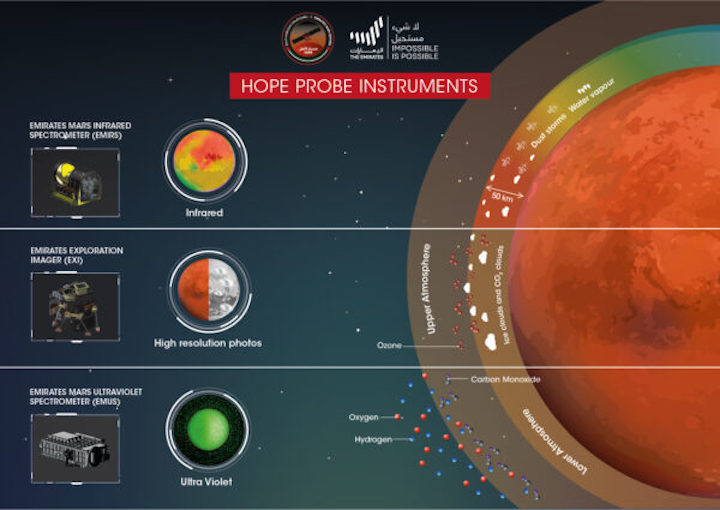
Hope Probe Instrument highlight
Credit: MBRSC
Quelle: Laboratory for Atmospheric and Space Physics
----
Update: 22.03.2021
.
UAE’s Hope probe prepares to transition into science orbit around Mars
The spacecraft will fire its thrusters for eight to nine minutes on March 23

The UAE’s Hope probe will soon perform the first of two manoeuvres to get closer to its science orbit around Mars.
The spacecraft, which reached the Red Planet on February 9, will begin its mission of collecting atmospheric data once it enters the target orbit in April.
On March 23, at 1am Gulf Standard Time, the probe will fire its thrusters for eight to nine minutes to correct its positioning.
I think it’s fair to say there is huge excitement now in our science team and among Mars scientists around the world
Omran Sharaf, team leader
For the past few weeks, Hope has been travelling as close as 1,063 kilometres to Mars’ planetary surface and as far away as 42,461 km.
The goal is to reach an elliptical science orbit of 20,000 km to 43,000 km, where it can then spend two years gathering data.
“Our Mars orbit insertion was highly successful and precisely targeted and this has allowed us to plan a reduction in transition to science manoeuvres, and also to move to our science orbit ahead of schedule,” said Omran Sharaf, team leader of the mission.
“We will commence science data gathering earlier in April than we had originally planned, and I think it’s fair to say there is huge excitement now in our science team and among Mars scientists around the world.”
The strategic orbital placement will allow the spacecraft to complete one full circle around the planet every 55 hours and capture a full planetary data sample every nine days.
Hope’s three scientific instruments, the Emirates eXploration Imager (EXI) – a high-resolution camera and an ultraviolet and infrared spectrometer, will capture data.
Several high-resolution, infrared and ultraviolet photos were released earlier this month that measured gases present in the Martian atmosphere.
Hope will study why gases crucial to life are escaping from the atmosphere. It will also trace movement of energy through the atmosphere and the planet’s weather dynamics.
The last manoeuvre before it enters its science orbit is scheduled for April 6.
Quelle: National
----
Update: 27.05.2021
.
Next steps for Hope probe’s mission to Mars
The orbiter has sent back thousands of scientific images as it measures atmospheric conditions on the Red Planet
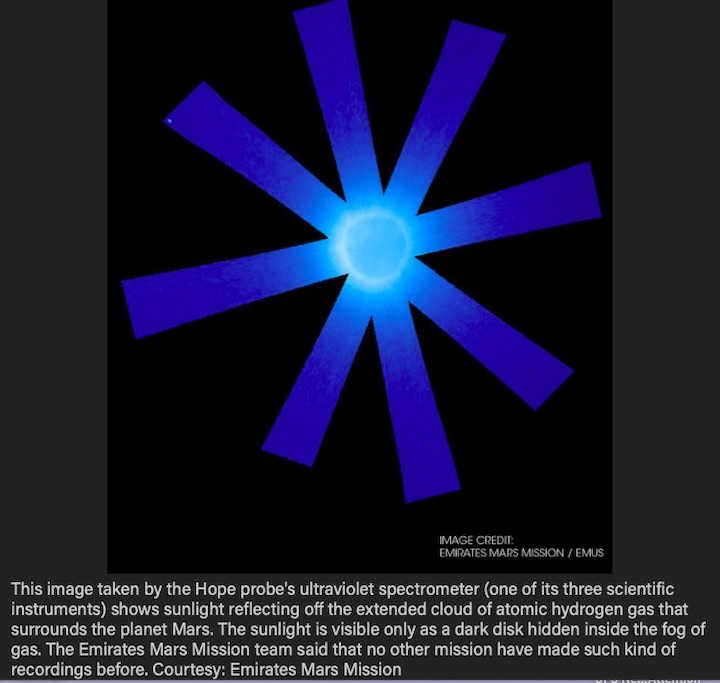
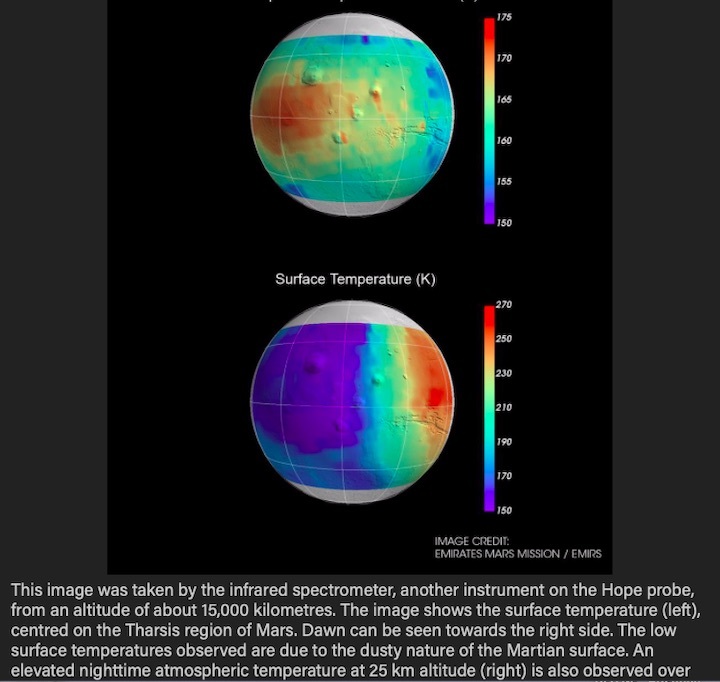
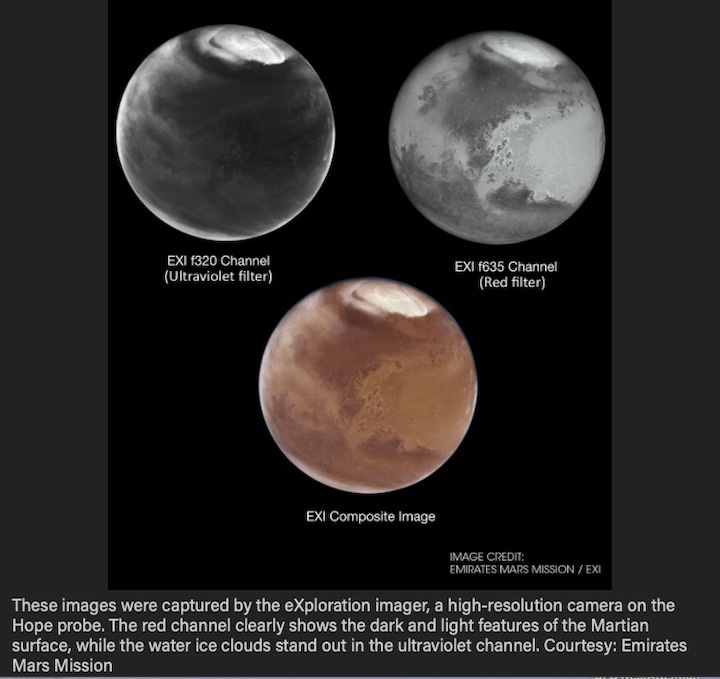
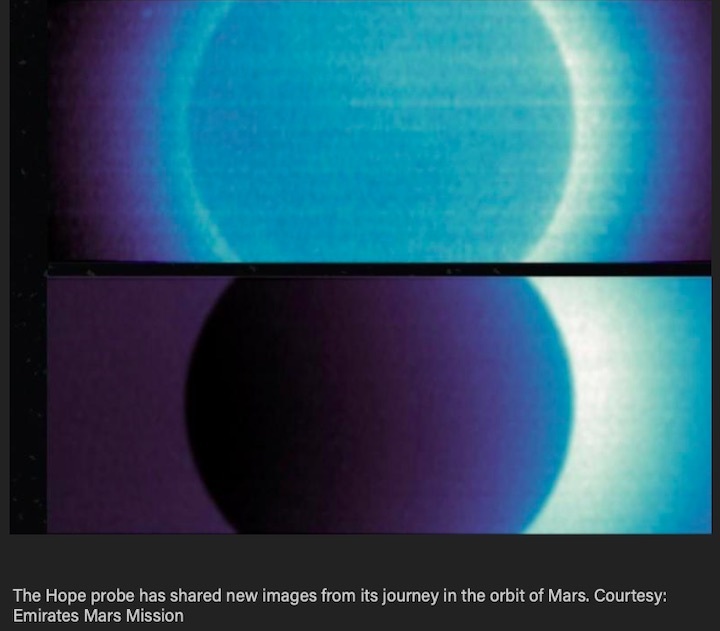
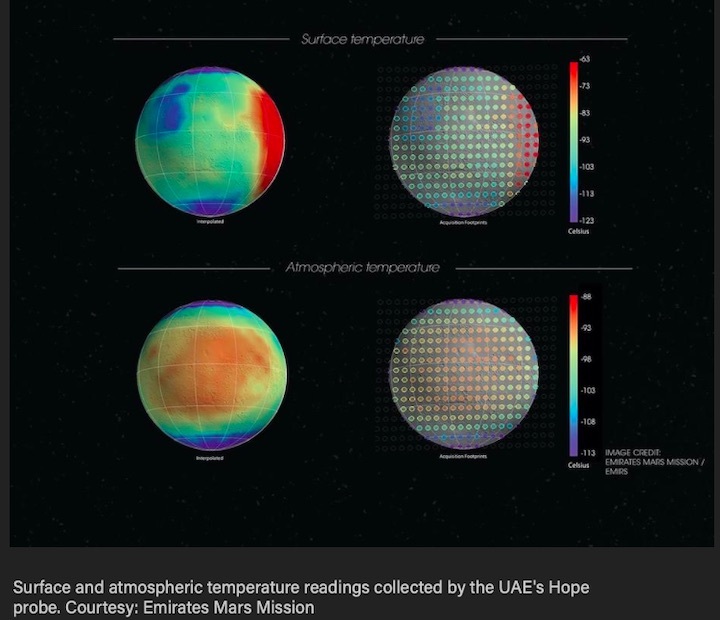
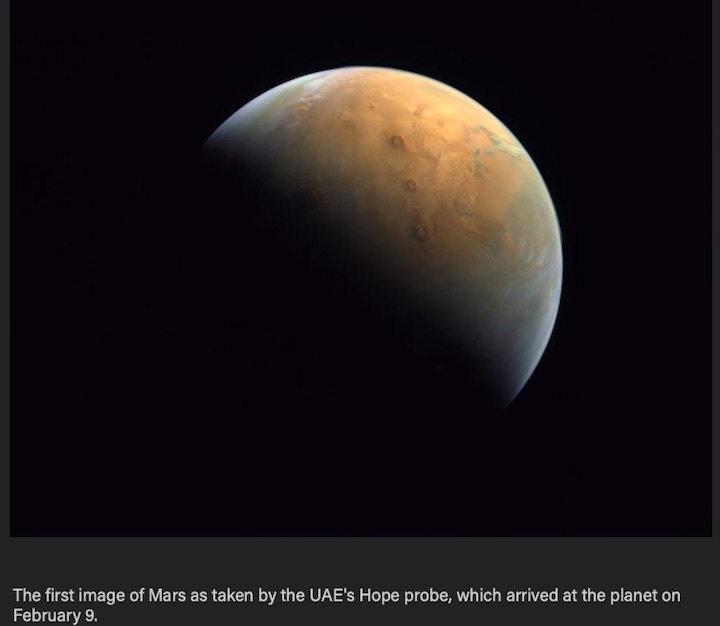
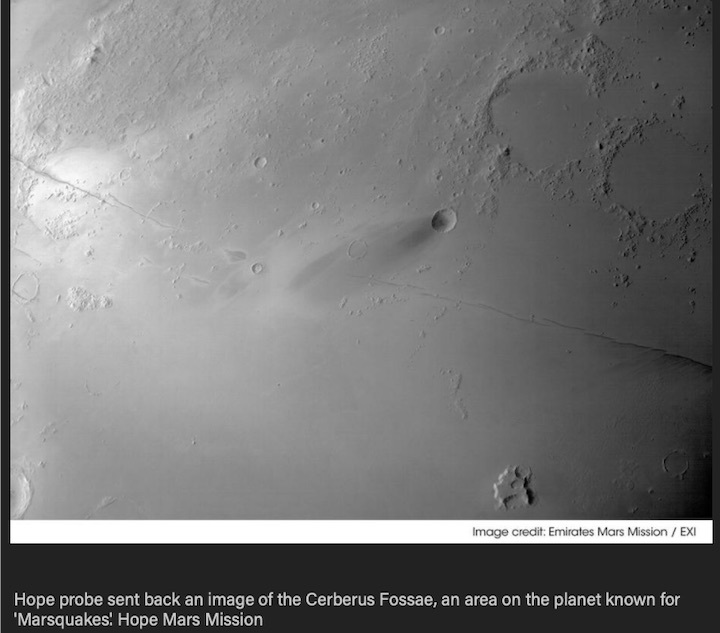

The Emirates Mars Mission is moving into its next phase, gathering data that will help scientists to study the atmosphere and weather of the Red Planet.
The Hope probe, which started orbiting Mars on February 9, activated its instruments on April 10, and has already sent back thousands of images.
Now, the orbiter will spend two years collecting extensive data on gases, including hydrogen, oxygen and carbon monoxide, that surround the planet.
The data will help scientists to understand why and how Mars, which may have once supported ancient life, lost most of its atmosphere.
“Following a successful cruise to Mars, a near-perfect Mars orbit insertion manoeuvre and our transition from Hope’s capture orbit to our science orbit, we have completed our commissioning, calibration and testing phase,” said the project’s director, Omran Sharaf.
“I am delighted to be able to report that the Mars Hope probe is perfectly positioned to commence its two-year science mission.”
Recent images taken by the ultraviolet spectrometer, one of Hope’s instruments, shows sunlight reflecting off an extended cloud of atomic hydrogen gas that surrounds the planet.
Hope was able to capture the phenomenon because its unique 25-degree elliptical orbit allows it to study the planet at different times of the day.
The ultraviolet spectrometer has sent 14,000 spectral-spatial images of the atmosphere.
Sarah Al Amiri, Minister of State for Advanced Technology and Chairwoman of the UAE Space Agency, said it was capable of collecting “a lot of new data”.
“The atomic hydrogen is formed by sunlight splitting water in the lower atmosphere, then diffuses to the upper atmosphere and escapes to space,” she said.
“The hydrogen is thickest close to Mars, circling the planet with a bright ring of light, and becomes thinner and dimmer further away.”
Quelle: National
+++
UAE's Emirates Hope Probe is ready to gather data from Mars
The Emirates Mars Mission will study the Martian atmosphere, the relationship between the upper layer and lower layer and scientists globally will have full access to a holistic view of the Martian atmosphere
The Emirates Mars Mission is ready to begin gathering data from the Martian planet after successfully completing practice exercises and ensuring instruments aboard are functioning properly.
The Hope Probe will study the Martian atmosphere, the relationship between the upper layer and lower layer and, for the first time, scientists globally will have full access to a holistic view of the Mars atmosphere at different times of the day, through different seasons.
“Following a successful cruise to Mars, a near-perfect Mars Orbit Insertion manoeuvre and our transition from Hope’s capture orbit to our science orbit, we have completed our commissioning, calibration and testing phase. I am delighted to be able to report that the Mars Hope probe is perfectly positioned to commence its two-years science mission,” said Omran Sharaf, Project Director of EMM.
The Hope Probe reached the Mars orbit in February after 204 days of travel to the red planet. In April, the probe’s three instruments – the Emirates Mars Ultraviolet Spectrometer (EMUS), the Emirates Exploration Imager (EXI) and the Emirates Mars Infrared Spectrometer (EMIRS) – were activated and have now been tested.
A statement from the mission said the “instruments and spacecraft are performing beyond expectations.”
“Hope is following its planned 20,000 – 43,000 kilometre elliptical science orbit, with an inclination to Mars of 25 degrees. The probe will complete one orbit of the planet every 55 hours and will capture a full planetary data sample every nine days,” the statement said.
Announced in July 2014 by the UAE President His Highness Sheikh Khalifa Bin Zayed Al Nahyan, and His Highness Sheikh Mohammed bin Rashid Al Maktoum, Vice President and Prime Minister of the United Arab Emirates and Ruler of Dubai, the Emirates Mars Mission has been developed by the Mohammed Bin Rashid Space Centre (MBRSC), in conjunction with its knowledge transfer partners and funded by the UAE Space Agency.
Quelle: Arabian Business
----
Update: 3.07.2021
.

